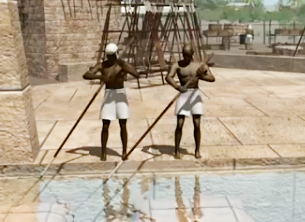When construction project manager Chris Massey visited Egypt wherever he looked, he saw problems with the perceived wisdom on how the pyramids, temples and tombs of the pharaohs were built.
Thousands of men are supposed to have dragged the building blocks across the desert in the searing heat.
- If limestone blocks were dragged up a mud brick ramp to be placed at the top of the Great Pyramid, where is the evidence of this huge ramp?
- How could materials such as wooden rollers and mud bricks take the strain put on them by tons of stone?
- How did the ancient project managers keep morale up amongst the dusty and tired workforce?
- Surely there must have been an easier way?
Massey looked around him and saw the greatest resource available to the Egyptians – the waters of the mighty Nile. He realized the Egyptians may have used the power of buoyancy to lift and move huge stones. In science, buoyancy is an upward force exerted by a fluid that opposes the weight of an immersed object.
This engaging account is the result of Massey’s pool-side ponderings, in which he gives a detailed alternative theory of how the ancient Egyptians could have used water to their advantage to make pyramid building much easier.

 Torbjörn Sassersson är grundare av NewsVoice som startade 2011. Torbjörn har arbetat inom media sedan 1995. Han har en fil kand (1992) inom miljövård från Stockholms Universitet. Stöd hans arbete genom en
Torbjörn Sassersson är grundare av NewsVoice som startade 2011. Torbjörn har arbetat inom media sedan 1995. Han har en fil kand (1992) inom miljövård från Stockholms Universitet. Stöd hans arbete genom en 